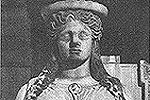
The Loop (continued)
Indeed, the fire hastened a process that had been going on for
some time; that is, the sorting out by function of the various
parts of the central business district. Different sections would
play different roles in the economic, social, political, and
cultural
life of the city. While the retail district prospered along State
Street, government was centered at City Hall on Clark Street.
Entertainment could be found along Randolph west of State Street.
And cultural life flourished along Michigan Avenue from the Chicago
Public Library to the Auditorium Building. This cultural center
was not allowed to expand into Grant Park, but it overflowed
onto
the lakefront sough of Roosevelt Road. After 1911 the Field
Museum of Natural History,
the Shedd Aquarium, the Adler Planetarium, and Soldier Field
were located there (See Figs. 1 and 2). LaSalle Street
became the center of Chicago's financial
district. The area south of Van Buren Street on State and Plymouth
Court was the vice district.
One example of this sorting-out trend can be seen in what happened
along South Wabash Avenue after the fire. Before the Chicago Fire,
Wabash Avenue was a quiet street of fine homes and churches. The
beautiful First Presbyterian Church and St. Paul's Universalist
Church stood below Adams on Wabash. A popular skating rink occupied
the northeast corner of Wabash and Jackson. This was a well-to-do
area which, even before the fire, had begun to change. In the
1860s Chicago's music businesses were located on Clark Street
near the entertainment district on Randolph. The Crosby Opera
House opened in 1865 on Washington Boulevard between State and
Dearborn. The downtown area had begun to differentiate by function.
The fire accelerated this trend. The wealthy moved their homes
away from the center of the city to Prairie Avenue and even to
the distant suburbs of Hyde Park and Washington Park. The economic
success of State Street transformed the southern part of the central
business district. The fire actually moved many of the retail
businesses temporarily into the former homes of the wealthy on
South Wabash and Michigan Avenues. Once the business community
returned to the heart of the city, these older homes were given
over to other enterprises or turned into cheap housing. The wealthy
had moved on.
«
previous
7
of 11
next
»
|
 |

|
 |
 
Figure
1: Caryatid near the south entrance of the Field Museum, 1985. »

Figure
2: Field
Museum of Natural History. Twelfth Street at Lake Shore Drive, 1937. »
|